Heating stoves for the home: all types and designs
Since time immemorial, man has used a stove to cook food and create heat in a house. Even now, in the age of high technology, the device, although it has undergone changes, has not lost its relevance. It’s even more profitable to get a helper because of the constantly rising prices for central heating.
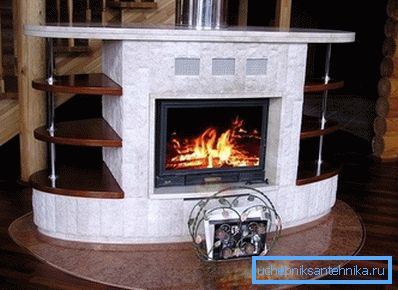
Differences by purpose
Depending on your preferences and requirements for the heater, you should choose a stove that most closely matches all parameters.
Here are the main categories of devices offered.
- Heating stove for home. It is designed exclusively to create heat in the room. More from it should not be expected, but the owner is guaranteed to warm up.

- Heating and cooking analog. This hostess is also equipped with an additional surface, so boiling water or cooking food on it is not a problem. Some models are equipped with an oven.
- Devices equipped with a heating shield. In this case, you can cook on the hob, and the heated gas from the firebox is fed into a special shield - a brick structure with smoke channels. The efficiency of such a stove is higher, it can warm a large area.
- Stove-fireplace. The design, in addition to being useful, also has a decorative function. Rest in the winter evenings will acquire a special charm.
- Kamenka for baths. Here are provided trays, heaters, to accommodate stones, giving heat.
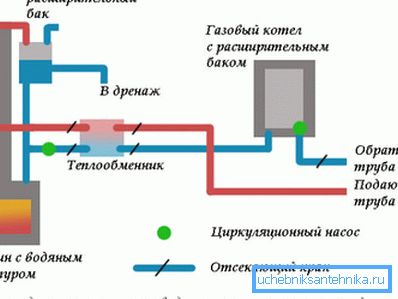
- Analogs with a water circuit. The equipment is able to create a full autonomous water heating. After the coil, the heated fluid is piped into the rooms. Thus, it is possible to provide heating even for a large cottage.
Design features
Modern stoves for heating a private house can be chosen in such a way as to add fuel when it is convenient for the owner.
Burning time

- Furnaces with firewood every 2/3 hours. Most often on sale is found this type. The devices are equipped with a small firebox, have compact dimensions and are good for use in the country or in a small country house.
- Heating furnaces of long burning. This is a more serious design, with an increased firebox. The frequency of fuel bookmarks varies from 6 to 12 hours. Throwing wood for the night, you can sleep peacefully in the morning.
- There are modified furnaces for home heating - with a protracted combustion mode (pyrolysis reaction). The process slows down due to the reduced access of air to the furnace.
- With continuous automatic burning process. Typically, these are coal-powered models. The service includes the periodic addition of coal and slag removal.
Heating temperature
It is worth paying attention to the different temperatures to which the furnace body is heated.
- Moderate warming up. The walls of the unit heat up to +90 ?. The properties are inherent in small stoves used for heating a small room.
- Increased warm up. This stove for heating a house of medium size. The case temperature reaches up to +120 ?.
- High warm. Here the temperature of the walls exceeds +120?
Gas movement
Depending on the technical characteristics laid down, the exhaust gas in the oven can circulate according to different schemes.
- Successively connected vertical channels pass gas through themselves. Falling down and rising, it uniformly heats the body over the entire surface.
- Parallel vertical channels are constantly raising and lowering gases simultaneously through all aisles.
- Horizontal, mounted in series chimneys, pass the gas gradually through the levels, higher and higher.
- The combined scheme can combine several types of chimneys, or is completely devoid of channels.
Forms of domestic stoves

Often, not only personal wishes, but the situation dictates a particular form of construction. It is especially difficult to choose a heater if the room is too cramped or has irregular geometry.
Therefore, stoves for home heating are produced with different dimensions, design and shape.
- Rectangular units.
- Round stove.
- Angular counterparts.
- Polygonal appliances.
Note! This is what is offered in stores. But there is always the opportunity to order the device of the required size and design. Especially impressive are the folded master copies, here the scope for imagination is unlimited.
Heat transfer
For the most part, the material from which the stove is made is able either to slowly or for a long time release the accumulated heat, or to cool down quickly, requiring a new fuel bedding.
- Heat-absorbing devices. The heater, even after complete attenuation of the fire, can remain hot for several hours. Most of these qualities have brick, ceramic and cast iron stoves.
- Devices with low heat capacity. Pleases extremely fast warm-up, but sad the same rapid cooling. This deficiency sin steel thin-walled units.
Equally important is the thickness of the walls, the thicker they are, the longer the oven retains the accumulated heat.
Note! If you are planning a stationary brick oven, do not skimp on the material. The instruction advises to build a hull of half-dead and more. In this case, the thermal return of the structure will be maximum, and she herself reliable.
Material selection
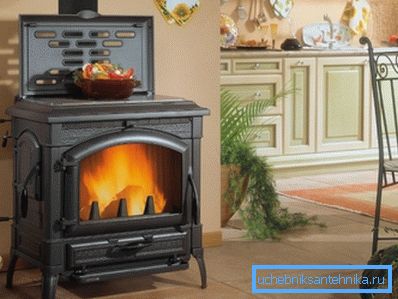
The number of offers makes your head spin, sellers praise the product, trying to adjust its characteristics to your taste. Do not rush to be carried out on marketing tricks, think over the purchase well in advance, even before going to the store. Otherwise, you risk becoming the owner of a beautiful, but uneconomical or inefficient thing.
The basis of the unit
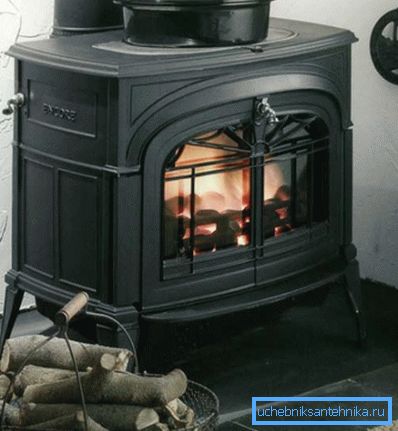
- Steel. Products from it are durable, lightweight, they are easy to transport or move around the house. But the heaters cool as quickly as they heat up. As a rule, they have small dimensions and a firebox, so firewood will have to be reported every two hours. For a large building, the purchase is inexpedient, but for a country house with a periodical stay in it is relevant.
- Cast iron. The material is famous for its durability, but also a considerable weight too. Cast iron heating furnaces for a medium-sized wooden house - just right. Especially since they are safer than steel prototypes. They warm up for a rather long time, but they also cool down slowly. Will delight the owner of the model with the function of the fireplace and antique design.
- Brick. Solid and capital furnaces in any style and various configurations are obtained from it perfectly. And today, in almost every village you can find a craftsman - a stove-set who can create a masterpiece. Here you and the bench, and the hob, and fireplace, and oven. All at the request and capabilities of the customer. But to transfer the creation to another place will not work. In addition, under such a furnace need large rooms.
- Prefabricated tiled structures. Such an oven is going to be used to heat the house with their own hands or with an assistant. The main thing is to control the purchase of the equipment and the availability of detailed instructions. Externally, the product in finished form looks presentable, pleases with performance, gives a long heat.
Facing coatings
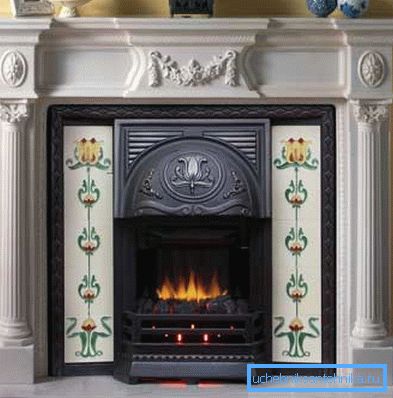
In most cases, the finished metal furnaces do not need further finishing. Enough to buy, bring and put in the right place.
This does not apply to stationary structures laid out of stone or heat-resistant concrete.
- Decorative rock. It is advisable to use a natural analog, rather than an artificial one. And with a small budget, you can pick up an inexpensive and beautiful material that has a lot of advantages.
- Facing brick. Finishing will turn out effective, will serve long only in the event that to apply heat resisting options. The range will allow you to choose the desired color and shade, in harmony with the interior.
- Tiles. Perhaps the most expensive option, because there are unique handmade tiles. On request, you can arrange a stove or fireplace in the national style.
Fuel types
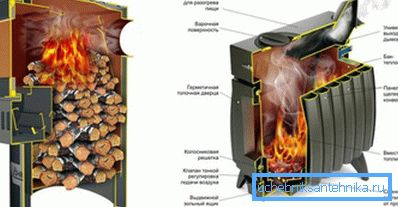
Initially, the Russian stove was heated with wood. The option is now acceptable, especially in regions with woodland.
But other types of fuel should not be ignored, the main thing is to find out what is more affordable and cheaper in your area.
- Wood. It burns well, but not as long as we would like. Therefore, the churbak in the furnace will have to enclose often, as well as rake the ashes. But a small heating and cooking stove for the house will please them with efficiency, especially if firewood is not a problem.
- Coal. Smolders much longer than a tree, giving off a large amount of heat. Having heated the stove in the evening, you can not worry until morning; the house will be warm and cozy. It is usually easy to get fuel, but coal will cost a little more than wood.

Note! Briquettes from wood waste, peat, cones. Often they are the cheapest and most affordable option. Especially if there is a woodworking workshop or company nearby.
Many craftsmen have adapted themselves to prepare briquettes from shavings, wood chips and sawdust, or to extract peat. Preparations for the winter significantly facilitate the life of the homeowner.
- Fuel oil, diesel fuel and other flammable liquids, the price of which is low. They are better suited not so much for household heaters as for an autonomous mini boiler room. Fuel barrels should not be stored in the house for safety reasons. Therefore, for the boiler and other things have to build a separate room.
- Natural or bottled gas. More often the second option is more accessible, it is also more convenient, since the balloon can be moved along with the stove. Fuel is not cheap, but it is always at hand, especially when hot water is needed, it can be heated for domestic use in a matter of minutes.
Conclusion
Even with a minimum budget is not worth freezing. The choice is so great that to leave without a purchase will not work. From the smallest stoves to the country, to capital systems, for a large country house.
The main thing - do not rush and buy a device that meets your requirements.
We recommend the video, where you will learn more about the furnaces.